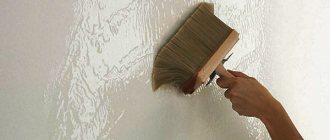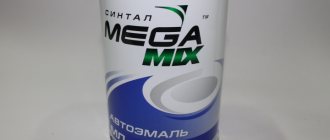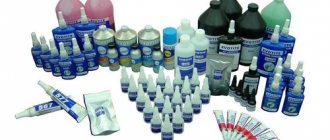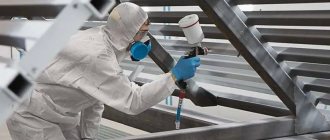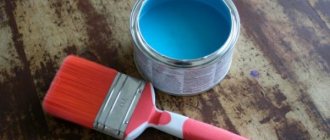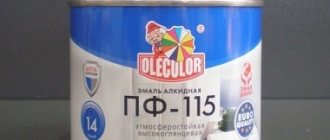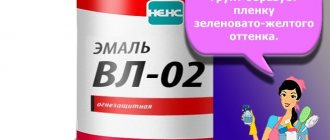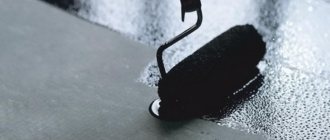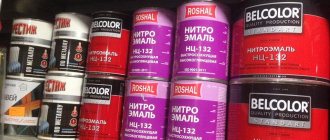GOST 6631-74 Group L24
STATE STANDARD OF THE UNION OF THE USSR ENAMEL GRADES NTs-132 Technical specifications Enamels NTs-132. Specifications
OKP 23 1422
Date of introduction 1975-07-01
ENTERED INTO EFFECT by the Decree of the State Committee of Standards of the Council of Ministers of the USSR dated August 23, 1974 N 2045. CHECKED in 1984 by the Decree of the State Standard dated 02/20/85. Fast. N 335 validity period extended until 07/01/90*
_______________
* The validity period was removed by the Decree of the State Standard of the USSR dated December 20, 1991 N 2022. (IUS N 4, 1992). INSTEAD OF GOST 6631-65 REISSUE (June 1985) with Amendments No. 1, 2, approved in June 1980, February 1985 Post. 335 02.20.85 (IUS 8-80, 5-85) Amendment No. 3 and Amendment No. 4 were introduced, approved and put into effect by resolutions of the USSR State Committee for Product Quality Management and Standards dated 09.22.89 N 2848 from 03.01.90, dated 12/20/91 N 2022 from 07/01/92 and published in IUS N 1, 1990, IUS N 4, 1992 Changes No. 3, 4 were made according to the text of IUS N 1, 1990, IUS N 4, 1992 This standard applies to NC-132 enamels of various colors, which are a suspension of SVP (pigment rolled with nitrocellulose, plasticizer and dispersant) in a solution of colloxylin and alkyd resin in a mixture of organic solvents with the addition of plasticizers. Enamels are intended for painting wooden and pre-primed metal surfaces of products used in atmospheric conditions. The coating system, consisting of two layers of NTs-132 enamel applied to a primed surface, must retain protective properties in a temperate climate for at least two years up to score AZ 1 according to GOST 9.407-84. Enamels are also used for painting products used indoors. The requirements of clause 1.5 regarding indicators 8, 9, 11, 12 are recommended, the remaining requirements of this standard are mandatory. (Changed edition, Amendment No. 3, 4).
1. BRANDS AND TECHNICAL REQUIREMENTS
1.1. Depending on the method of application to the surface, enamel is produced in two grades: NTs-132K - for application with a brush; NTs-132P - for application by spraying.
1.2. Enamels must be produced in accordance with the requirements of this standard according to the recipe and technological regulations approved in the prescribed manner.
1.3. Enamels must be produced in the following colors with the corresponding OKP codes specified in the mandatory appendix 1. The correspondence of the changed designations of enamels colors according to GOST 6631-74 with amendment 3 is given in reference appendix 3. (Changed edition, Amendment No. 2, 3).
1.4. Before use, enamel grade NTs-132K is diluted with solvent grade 649, enamel grade NTs-132P with solvent grade 646 according to GOST 18188-72.
1.5. In terms of physical and mechanical parameters, enamels must comply with the requirements and standards specified in Table 1.
Table 1
| Standard for the brand | ||||||
| Indicator name | NTs-132K | NTs-132P | Test method | |||
| First grade | Second grade | First grade | Second grade | |||
| 1. Enamel film color: | Must be within the permissible deviations established by the “Card Index” color samples (standards) or control color samples | According to clause 3.3 | ||||
| red | 42, 44 | 42, 44 | ||||
| cream 200 | 200, 201 | 200, 201 | ||||
| light greenish yellow | 246, 247 | 246, 247 | ||||
| cream | 270, 271 | 270, 271 | ||||
| golden yellow | 285, 286 | 285, 286 | ||||
| pistachio 309 | 309, 328 | 309, 328 | ||||
| light gray-green | 319, 352 | 319, 352 | ||||
| pale green | 340, 360 | 340, 360 | ||||
| dark blue-green | 356, 357 | 356, 357 | ||||
| gray-green | 365, 396 | 365, 396 | ||||
| pistachio 388 | 388, 389 | 388, 389 | ||||
| light blue | 448, 467 | 448, 467 | ||||
| gray-blue | 453, 454 | 453, 454 | ||||
| gray-blue | 463, 464 | 463, 464 | ||||
| light gray 505 | 505, 513 | 505, 513 | ||||
| light gray 583 | 583, 584 | 583, 584 | ||||
| light beige | 620, 621 | 620, 621 | ||||
| red-brown | 635, 636 | 635, 636 | ||||
| orange-brown | 673, 674 | 673, 674 | ||||
| protective | 753, 754 | 753, 754 | ||||
| tobacco | 794, 795 | 794, 795 | ||||
| dark grey | 812, 813 | 812, 813 | ||||
| white | Color samples | |||||
| black | Color samples | |||||
| 2. Appearance of the enamel film | After drying, the enamel film should be smooth, uniform, without wrinkles or foreign inclusions. | According to clause 3.3 | ||||
| 3. Film gloss, %, not less | 55 | 40 | 55 | 40 | According to GOST 896-69 | |
| 4. Conditional viscosity at temperature (20.0±0.5) °C according to a viscometer type VZ-246 (or VZ-4), s | 100-150 | 60-100 | According to GOST 8420-74 and clause 3.3a of this standard | |||
| 5. Mass fraction of non-volatile substances,%, for enamel: | According to GOST 17537-72 and clause 3.3b of this standard | |||||
| black | 22-28 | 22-28 | ||||
| red | 29-35 | 29-35 | ||||
| other colors | 32-40 | 32-40 | ||||
| 6. Covering power of the dried film, g/m, no more, for enamel: | According to GOST 8784-75, section 1 | |||||
| red | 80 | 80 | ||||
| cream 200 | 100 | 100 | ||||
| light greenish yellow | 80 | 80 | ||||
| cream 270 | 100 | 100 | ||||
| golden yellow | 90 | 90 | ||||
| pistachio 309 | 50 | 50 | ||||
| light gray-green | 60 | 60 | ||||
| pale green | 60 | 60 | ||||
| dark blue-green | 30 | 30 | 30 | 30 | ||
| pistachio 388 | 50 | 50 | 50 | 50 | ||
| gray-green | 50 | 50 | 50 | 50 | ||
| light blue | 80 | 80 | 80 | 80 | ||
| gray-blue | 40 | 40 | 40 | 40 | ||
| gray-blue | 50 | 50 | 50 | 50 | ||
| light gray 505 | 50 | 50 | 50 | 50 | ||
| light gray 583 | 45 | 45 | 45 | 45 | ||
| light beige | 60 | 60 | 60 | 60 | ||
| red-brown | 40 | 40 | 40 | 40 | ||
| orange-brown | 80 | 80 | 80 | 80 | ||
| protective | 60 | 60 | 60 | 60 | ||
| tobacco | 40 | 40 | 40 | 40 | ||
| dark gray | 40 | 40 | 40 | 40 | ||
| white | 100 | 120 | 100 | 120 | ||
| black | 30 | 30 | 30 | 30 | ||
| 7. Drying time at temperature (20 ± 2) °C, h, no more than: | According to GOST 19007-73 and clause 3.4 of this standard | |||||
| up to degree 3 | 2 | 3 | 2 | 3 | ||
| up to degree 4 | 24 | 24 | 24 | 24 | ||
| 8. Elasticity of the film, when bending, mm, no more | 1 | 1 | 1 | 1 | According to GOST 6806-73 | |
| 9. Film strength upon impact with a U-1 type device, cm, not less | 50 | 50 | 50 | 50 | According to GOST 4765-73 | |
| 10. Film hardness, conventional units, not less than: | According to GOST 5233-89 | |||||
| using a pendulum device type M-3 | 0,30 | 0,22 | 0,30 | 0,22 | ||
| using a pendulum device type TML (pendulum A) | 0,15 | — | 0,15 | — | ||
| 11. Resistance of the enamel film at a temperature of (20±2) °C to the static effects of water, h, not less | 1 | 1 | 1 | 1 | According to GOST 9.403-80 (section 2) and clause 3.5 of this standard | |
| 12. Resistance of the enamel film at a temperature of (20 ± 2) °C to the static effects of industrial oil, h, not less | 6 | 6 | 6 | 6 | According to GOST 9.403-80 (section 2) and clause 3.5 of this standard | |
Notes:
1. It is allowed to use a VZ-4 type viscometer to measure conditional viscosity until 01/01/93.
2. The norm for indicator 10 when determined on an M-3 type device is valid until 01/01/95; on a TML type device (pendulum A) it is not rejected until 01/01/95. Definition is required. (Changed edition, Amendment No. 2, 3, 4).
Advantages and disadvantages
This enamel is very popular today, as it has many important advantages:
- excellent elasticity, so enamel can be used to paint structures of any geometric shape and relief;
- due to its high moisture resistance, the paint can be used in damp buildings, damp structures, as well as outdoors;
- has a long service life and excellent wear resistance, so the original appearance of the painted product is preserved for several years;
- dried paint is very easy to care for, it can be washed using household chemicals, including abrasives;
- is resistant to ultraviolet rays, so the enamel layer does not fade in the sun and does not crack over time;
- is not afraid of sudden temperature changes, can be used in aggressive environments, as well as in cold and hot climates;
- has a good combination of low price and excellent quality, thanks to which the consumer saves money and gets excellent results;
- A large selection of colors makes it possible to implement any design solutions. After painting, the surface becomes glossy.
Despite these advantages, this enamel has several disadvantages, one of them is the high toxicity of the solution. When working with this mixture, you must follow safety precautions, use a respirator, gloves and goggles. If application is carried out indoors, there must be good ventilation. Another disadvantage is the flammability of the composition, so you should not paint objects near sources of open fire and heating devices, especially those with electric heating elements.
The best manufacturers
Various brands are engaged in the production of enamel. This helps you choose the best option based on your needs.
"Belcolor"
This enamel is popular among consumers.
Advantages and disadvantages
uniform coating; bright shades; affordable price; short drying period;
presence of chemical components in the composition; the need to use personal protective equipment.
I like it I don't like it
"Tex"
This product is sold in many hardware stores.
Advantages and disadvantages
quality certificates; low price; a wide range of.
flammable properties; toxicity.
I like it I don't like it
"Lakra"
The products of this company are manufactured in different countries - Poland, Canada, Switzerland.
Advantages and disadvantages
affordable prices; high quality; variety of shades.
presence of chemicals; the need to use protective equipment when painting.
I like it I don't like it
"Continental"
This is a relatively young company, which is characterized by rapid development and capacity expansion.
Advantages and disadvantages
compliance with sanitary and epidemiological standards; high quality; wide range of colors; affordable prices.
the need to use protective equipment during work; flammable properties.
I like it I don't like it
Final rating table
Enamel NTs-132 is considered a popular product that can be used for painting various types of surfaces
It is important to strictly follow the application instructions and safety rules.
ACCEPTANCE
2.1. Acceptance rules - according to GOST 9980.1-86.
2.2. Norm for indicator 3 of table. 1 The manufacturer determines periodically in every hundredth batch.
2.3. The need to conduct tests according to the recommended indicators of table. 1 (8, 9, 11 12) the manufacturer and the consumer are determined when concluding a contract for the supply of products.
2.4. Every hundredth batch is subjected to periodic testing for compliance with all requirements and standards of this standard.
2.5. If unsatisfactory results of periodic tests are obtained, the manufacturer checks each batch until satisfactory test results are obtained in a row of at least three batches.
Section 2. (New edition, Amendment No. 4).
MANUFACTURER'S WARRANTY
5.1. The manufacturer guarantees that the enamel meets all the requirements of this standard, subject to storage and transportation conditions.
(Changed edition, Amendment No. 2).
5.2. The guaranteed shelf life of enamels is one year from the date of manufacture.
During storage, a decrease in the viscosity of enamels below the established norm is allowed, provided that the enamel complies with the other requirements of this standard.
5.1; 5.2. (Changed edition, Amendment No. 2).
Application rules
Depending on the type of enamel chosen, a spray bottle or brush is used. Apply the mixture with smooth, leisurely movements.
After applying the first layer, it is important to wait about 2-3 hours, after which it is advisable to apply another layer. When the second layer is completely dry, you can polish the surface
Since this enamel contains organic solvents, it is flammable, so it should not be applied near open flames or sparks. Paint fumes are toxic, therefore, if painting is done in a room, it must be ventilated both during the work and for several hours after painting is completed. You should work with gloves and goggles to prevent the mixture from getting into your eyes and skin. After finishing dyeing, wash your face and hands thoroughly.
Peculiarities
NTs-132 enamel has been produced since the 70s of the last century, and it is difficult to believe that paint and varnish compositions have not yet been invented that would surpass it in their characteristics. Unlike paints, enamels form, after complete hardening, a smooth, uniform layer that protects the surface from various influences.
Initially, the main difference between enamel and paint was the type of thinning liquid. For enamel coatings, volatile compositions on an organic basis were used. In the case of paint, it could be drying oils or ordinary water. Over time, more and more water-dispersion enamels and acrylic-based coatings began to appear.
The letters NTs indicate that this enamel belongs to the group of nitrocellulose, that is, paints and varnishes made on the basis of nitrocellulose. This is a white fibrous structure, loose in appearance, reminiscent of ordinary cellulose and obtained from it by treatment with nitrogen.
The composition of NC-132 includes volatile and non-volatile parts. The first group includes alkyd resins (No188 according to the classification of resins), colloxylin-nitrocellulose with a nitrogen content of 10.7-12.2%, plasticizing additives and pigmenting particles. The non-volatile group differs for different types of enamels. It includes either 40% toluene, butyl or ethyl alcohol, about 15% active high-boiling solvents and slightly less low-boiling ones. In the second case, xylene is added instead of toluene, and solvents reach 30%. To improve decorative properties and smooth surface distribution, an anti-flotation additive and an additive to increase fire resistance can be added.
Manufacturers pay attention to the exceptional resistance of NC-132 enamel to various influences. In addition, the following positive qualities are noted:
In addition, the following positive qualities are noted:
- high strength and wear resistance;
- elastic structure suitable for use of any shape and surface shape;
- water resistance allows the enamel to be used in buildings with high humidity and outdoors;
- ease of care for surfaces coated with paints and varnishes - can be washed with any household products;
- the enamel layer can be ground and polished to give a glossy shine, which will further affect the decorative appearance of the products;
- the coating does not fade in the sun and is not susceptible to ultraviolet radiation;
- withstands strong temperature fluctuations;
- the material is economical and has a low price;
- long service life. When treating the surface with enamel in two layers in moderate climatic conditions, the coating can retain its decorative and quality features for up to two years.
Manufacturers
Factories producing NTs-132 enamel and other coatings are located in many cities in Russia.
NPO Ladoga has long been widely known and has two production facilities - in Omsk and in Crimea. Novosibirsk has developed a system of discounts for regular customers and a dealer program to facilitate the sale of its high-quality and budget products.
Belkolor LLC is popular among the average consumer. Buyers note the excellent coverage, bright colors and quick drying of NC-132 enamel from this manufacturer. The Belgorod enterprise has a twenty-year history; it has grown from a small workshop into an international brand with premium lines that are not inferior in quality to their foreign counterparts.
LMB gets good reviews. The availability of the product in a variety of hardware stores, combined with low price tags, makes it a worthy competitor in the paint and varnish market. The manufacturer is ready to confirm the quality of its products with many certificates.
The group manufactures its products in Canada, Switzerland, Poland and other European countries. Attractive prices are due to the presence of production facilities in our country. Enamels maintain the Western level of quality characteristics.
Continental LLC is a rapidly developing young company in the Russian construction market. But high quality standards, dynamic development and increased production capacity, combined with a huge range of products, allowed them to occupy their niche in the paint and coatings market. Enamels of the Krafor brand, produced by this manufacturer, are positioned as complying with GOST and sanitary-epidemiological standards. The company's factories are located in many cities in central Russia, in Udmurtia, as well as in the Czech Republic, Slovakia and Serbia.
For an overview of NC-132 enamel, see the following video.
Instructions for use of enamel NTs-132
Nitro enamels dry quickly, which must be taken into account when applying with a spray gun. At the same time, the paint sprayer allows you to obtain a high-quality surface when painting, but when working with another tool, drips are possible.
The declared consumption of nitro enamel is 100-120 g/m2.
What is the sequence of work with NTs-132 paint when applied to a metal surface?
|
What is the sequence of work with NTs-132 paint when applied to a wooden surface?
|
Surface preparation before painting
Before applying enamel, it is imperative to prepare the surface. To do this, all dust, dirt, and debris are carefully removed, and the base is degreased. If paint is applied to a wooden surface, traces of rot and mold must be removed from it, and if a metal part is painted, rust and traces of corrosion must be removed. After cleaning, metal surfaces must be primed using one of the following mixtures: GF-020-021, FL-03K, GF-032.
It is also advisable to prime a wooden base; for this you can dilute the enamel with solvent 646, the proportion should be 5 to 1. It is not necessary to prime the wood. A layer of enamel is applied only to a completely clean and dry surface. If there is a thickened film on the paint, it must be removed and the mixture must be thoroughly mixed, and if the paint and varnish material is too thick, solvent 646 is used.
ENAMEL NTs-132
GOST 6631-74
NTs-1320 enamel is intended for painting wooden and pre-primed metal surfaces of products used in atmospheric conditions with a temperate climate and indoors of all types of buildings. For priming, primers such as GF-021, AK-070, FL-03K, VL-02 are used. It is allowed to apply enamel on ferrous metals without prior priming.
Compound
: NC-132 enamels are a composition of nitrocellulose and alkyd resin. Designed for external and internal painting of pre-primed metal, wood and other surfaces, including those exposed to weather conditions.
Distinctive qualities of nitro enamel:
- Enamel NTs – 132 is resistant to temperature changes from -12°C to +60°C.
- NC-132 enamel reliably protects the surface from the effects of detergents and water.
- Enamel NTs-132 withstands grinding and polishing.
- Quick drying.
- NC-132 enamel is highly stable during storage and transportation.
- After drying, the coating has high elasticity, strength, durability, and increased hiding power.
Consumption
for a single layer coating depending on the color 30-120 g/m2.
TECHNICAL CHARACTERISTICS OF ENAMEL NTs-132:
| Indicator name | Requirements according to GOST |
| Enamel film color | Smooth, uniform surface without delamination, pockmarks, drips, wrinkles and foreign inclusions. |
| Conditional viscosity according to a VZ-246 viscometer with a nozzle diameter of 4 mm, s | 60-100 |
| Drying time at T20? C, h, no more | 2 |
| Mass fraction of non-volatile substances, % | 22-40 |
| Enamel consumption, g/m?, no more | 30-120 |
| Film gloss, %, not less | 55 |
| Film elasticity when bending, mm, no more | 1 |
| Film strength upon impact with a U-1 type device, cm, not less | 50 |
| Film hardness, conventional units, according to the TML device (pendulum A), not less | 0,15 |
Application:
: Clean the metal surface from dirt, scale and rust. Pre-dry the wooden surface, clean it with sandpaper and wipe with a soft cloth to remove dust. Surface priming: option 1: coat metal and wooden surfaces with a primer for metal and wood (FL-03K, GF-0163, GF-021, GF-0119). Option 2: prime wooden surfaces with NTs-132 enamel, diluted with a solvent (646, 647, acetone) to 10-20% by weight of the enamel. Before applying enamel NTs-132, stir, first removing the film from the surface. If necessary, dilute NC-132 enamel with solvent 646. NC-132 enamel is applied with a brush or paint sprayer in one or two layers to the prepared surface. NTs-132 enamel is applied to the surface to be painted using pneumatic or airless spray, roller or brush.
Storage:
The guaranteed shelf life of NC-132 enamel is 12 months from the date of manufacture.
Kinds
The types and technical parameters of NTs-132 enamel are regulated by GOST 6631-74.
There are two types of coatings:
- NTs-132 “K” is designed for application with a brush and has a certain thickness, but it can be diluted with a solvent to a more liquid consistency;
- NTs-132 “P” is a liquid form suitable for spraying with a spray bottle.
Technical characteristics of enamel.
- The ambient air temperature for using paints and varnishes should be in the range from -12 to +60 C.
- 120 minutes after application, the surface treated with NTs-132 may become slightly sticky. Full use is possible a day after staining.
- The film layer formed by the enamel after hardening is characterized by excellent smoothness, the absence of streaks, spots, bumps and depressions.
- The hardness index is at least 0.15 cu. e. It is determined by a special pendulum device TML.
- The U-1 device allows you to measure the impact strength of a layer - at least 50 cu. e.
- The gloss of the composition is in the range of 40-55%.
- The mass fraction of volatile substances can be easily determined by the color of the liquid. For black enamels it is the lowest (22-28%), in other shades there are more than 29% volatile compounds.
- The shelf life when kept in sealed packaging without violating storage conditions is set at 1 year.
NTs-132 enamels are produced in a variety of convenient formats in cans, ranging from 0.7 kg, 1 kg, 1.7 kg and up to large barrels for industrial facilities of 17, 25 kg and more.
TEST METHODS
3.1. Sampling - according to GOST 9980.2-86.
3.2. Preparing samples for testing
The hardness and gloss of the film are determined on special-purpose glass plates measuring 90×120 mm and 1.2 mm thick according to TU 21-0284461-058-90. The elasticity of the film during bending is determined on plates made of black tin according to GOST 13345-85 with a size of 20×150 mm and a thickness of 0.25 - 0.32 mm.
The strength of the film upon impact is determined on sheet steel plates in accordance with GOST 16523-89, measuring 70×150 mm with a thickness of 0.5 mm.
All other indicators are determined on plates made of black tin or sheet steel measuring 70x150 mm. Plates for coating are prepared in accordance with GOST 8832-76, section. 3.
Conditional viscosity, mass fraction of non-volatile substances and degree of grinding are determined in undiluted enamels.
The tested enamel is diluted with appropriate solvents to a viscosity of 18 - 20 s using a VZ-246 (or VZ-4) type viscometer with a nozzle diameter of 4 mm, filtered through a sieve with a mesh 01 - 02 according to GOST 6613-86 and applied to prepared plates in one layer paint sprayer. The thickness of the dried film of a single-layer coating should be 18 - 23 microns.
To determine color, appearance and gloss, enamel is applied to the plates in two layers. The thickness of the two-layer coating is 35 – 45 microns.
To determine the resistance of the enamel film to the static effects of water and mineral oil, the enamel is applied in two layers over a glypthal or pentaphthalic primer, and the primer is applied to both sides of the plate. The thickness of the coating system should be 45 – 55 microns.
Drying of the second layer of enamel when determining color and appearance and the last layer when determining hiding power is carried out at (20 ± 2) ° C for 3 hours, and for enamel of the first quality quality - for 2 hours.
To determine all other indicators, drying of a single-layer coating and the second layer of a two-layer coating is carried out according to paragraph 8 of the table. 1 to degree 4 or at a temperature of 60 °C for 3 hours, tested according to indicators 3, 8, 9, 10 of table. 1 is carried out without holding the samples after cold drying and 3 hours at a temperature of (20 ± 2) °C after hot drying.
Drying between layers is carried out at a temperature of (20 ± 2) °C for 1 hour.
In case of disagreement in assessing the quality of enamels, dry the coating to determine the indicators according to points 3, 9, 10, 11, 12 of table. 1 is carried out according to point 8 of the table. 1 to degree 4.
(Changed edition, Amendment No. 2, 3, 4).
3.3. The color of the dried enamel film is determined by visual comparison with the color of the corresponding samples (standards) of the “Card Index” color or control color samples in natural or artificial daylight diffused light. The samples to be compared should be in the same plane at a distance of 300 - 500 mm from the observer’s eyes at a viewing angle that excludes surface gloss. In cases of disagreement in the assessment, the determination of color in natural daylight is taken as the final result.
The appearance of the dried enamel film is determined visually in diffuse daylight.
(Changed edition, Amendment No. 3).
3.3a. Conditional viscosity is determined using a viscometer type VZ-246 (or VZ-4) with a nozzle diameter of 4 mm.
(Changed edition, Amendment No. 3).
3.3b. The mass fraction of non-volatile substances is determined according to GOST 17537-72. A sample of the tested enamel weighing 1.5–2 g is placed in a drying cabinet and kept at a temperature of (105 ± 2) °C. The first weighing is carried out after 1.5 hours of exposure in the cabinet, and subsequent weighings are carried out every 30 minutes until constant weight.
It is possible to determine the mass fraction of non-volatile substances under an infrared lamp at a temperature of (105 ± 2) °C. If there is disagreement in the assessment of the mass fraction of non-volatile substances, the final result is determination in an oven.
(Introduced additionally, Amendment No. 2).
3.4. Drying time is determined according to GOST 19007-73.
When determining the drying time to degree 3, minor marks are allowed.
3.5. Determination of the resistance of the enamel film to the static effects of water and industrial oil.
3.5.1. The resistance of the film to the static effects of water and industrial oil is determined according to GOST 9.403-80, section. 2, in this case, distilled water is used in accordance with GOST 6709-72 and industrial oil in accordance with GOST 20799-88. Painted and dried samples are placed in the test solution at 2/3 of the height and the plates are kept in it for the time specified in paragraph 12 of the table. 1. After testing, the plates with the film are kept in air for 2 hours at a temperature of (20 ± 2) °C and the appearance of the film is examined.
Slight lightening and dulling when tested in water and very slight darkening when tested in oil is acceptable.
(Changed edition, Amendment No. 1, 2, 3).
BRANDS AND TECHNICAL REQUIREMENTS
1. BRANDS AND TECHNICAL REQUIREMENTS
1.1. Depending on the method of application to the enamel surface, two brands are produced: NTs-132K - for application with a brush; NTs-132P – for application by spraying.
1.2. Enamels must be produced in accordance with the requirements of this standard according to the recipe and technological regulations approved in the prescribed manner.
1.3. Enamels must be produced in the following colors with the corresponding OKP codes specified in the mandatory Appendix 1. The correspondence of the changed designations of enamels colors according to GOST 6631-74 with Amendment 3 is given in Reference Appendix 3. (Changed edition, Amendment No. 2, 3).
1.4. Before use, enamel grade NTs-132K is diluted with solvent grade 649, enamel grade NTs-132P is diluted with solvent grade 646 according to GOST 18188-72.
1.5. In terms of physical and mechanical parameters, enamels must comply with the requirements and standards specified in Table 1.
Table 1
| Standard for the brand | |||||
| Indicator name | NTs-132K | NTs-132P | Test method | ||
| First grade | Second grade | First grade | Second grade | ||
| 1. Enamel film color: | Must be within the permissible deviations established by the “Card Index” color samples (standards) or control color samples | According to clause 3.3 | |||
| red | 42, 44 | 42, 44 | |||
| cream 200 | 200, 201 | 200, 201 | |||
| light greenish yellow | 246, 247 | 246, 247 | |||
| cream | 270, 271 | 270, 271 | |||
| golden yellow | 285, 286 | 285, 286 | |||
| pistachio 309 | 309, 328 | 309, 328 | |||
| light gray-green | 319, 352 | 319, 352 | |||
| pale green | 340, 360 | 340, 360 | |||
| dark blue-green | 356, 357 | 356, 357 | |||
| gray-green | 365, 396 | 365, 396 | |||
| pistachio 388 | 388, 389 | 388, 389 | |||
| light blue | 448, 467 | 448, 467 | |||
| gray-blue | 453, 454 | 453, 454 | |||
| gray-blue | 463, 464 | 463, 464 | |||
| light gray 505 | 505, 513 | 505, 513 | |||
| light gray 583 | 583, 584 | 583, 584 | |||
| light beige | 620, 621 | 620, 621 | |||
| red-brown | 635, 636 | 635, 636 | |||
| orange-brown | 673, 674 | 673, 674 | |||
| protective | 753, 754 | 753, 754 | |||
| tobacco | 794, 795 | 794, 795 | |||
| dark grey | 812, 813 | 812, 813 | |||
| white | Color samples | ||||
| black | Color samples | ||||
| 2. Appearance of the enamel film | After drying, the enamel film should be smooth, uniform, without wrinkles or foreign inclusions. | According to clause 3.3 | |||
| 3. Film gloss, %, not less | 55 | 40 | 55 | 40 | According to GOST 896-69 |
| 4. Conditional viscosity at temperature (20.0±0.5) °C according to a viscometer type VZ-246 (or VZ-4), s | 100-150 | 60-100 | According to GOST 8420-74 and clause 3.3a of this standard | ||
| 5. Mass fraction of non-volatile substances, %, for enamel: | According to GOST 17537-72 and clause 3.3b of this standard | ||||
| black | 22-28 | 22-28 | |||
| red | 29-35 | 29-35 | |||
| other colors | 32-40 | 32-40 | |||
| 6. Covering power of the dried film, g/m, no more, for enamel: | According to GOST 8784-75, section 1 | ||||
| red | 80 | 80 | |||
| cream 200 | 100 | 100 | |||
| light greenish yellow | 80 | 80 | |||
| cream 270 | 100 | 100 | |||
| golden yellow | 90 | 90 | |||
| pistachio 309 | 50 | 50 | |||
| light gray-green | 60 | 60 | |||
| pale green | 60 | 60 | |||
| dark blue-green | 30 | 30 | 30 | 30 | |
| pistachio 388 | 50 | 50 | 50 | 50 | |
| gray-green | 50 | 50 | 50 | 50 | |
| light blue | 80 | 80 | 80 | 80 | |
| gray-blue | 40 | 40 | 40 | 40 | |
| gray-blue | 50 | 50 | 50 | 50 | |
| light gray 505 | 50 | 50 | 50 | 50 | |
| light gray 583 | 45 | 45 | 45 | 45 | |
| light beige | 60 | 60 | 60 | 60 | |
| red-brown | 40 | 40 | 40 | 40 | |
| orange-brown | 80 | 80 | 80 | 80 | |
| protective | 60 | 60 | 60 | 60 | |
| tobacco | 40 | 40 | 40 | 40 | |
| dark gray | 40 | 40 | 40 | 40 | |
| white | 100 | 120 | 100 | 120 | |
| black | 30 | 30 | 30 | 30 | |
| 7. Drying time at temperature (20 ± 2) °C, h, no more than: | According to GOST 19007-73 and clause 3.4 of this standard | ||||
| up to degree 3 | 2 | 3 | 2 | 3 | |
| up to degree 4 | 24 | 24 | 24 | 24 | |
| 8. Elasticity of the film, when bending, mm, no more | 1 | 1 | 1 | 1 | According to GOST 6806-73 |
| 9. Film strength upon impact with a U-1 type device, cm, not less | 50 | 50 | 50 | 50 | According to GOST 4765-73 |
| 10. Film hardness, conventional units, not less than: | According to GOST 5233-89 | ||||
| using a pendulum device type M-3 | 0,30 | 0,22 | 0,30 | 0,22 | |
| using a pendulum device type TML (pendulum A) | 0,15 | – | 0,15 | – | |
| 11. Resistance of the enamel film at a temperature of (20±2) °C to the static effects of water, h, not less | 1 | 1 | 1 | 1 | According to GOST 9.403-80 (section 2) and clause 3.5 of this standard |
| 12. Resistance of the enamel film at a temperature of (20 ± 2) °C to the static effects of industrial oil, h, not less | 6 | 6 | 6 | 6 | According to GOST 9.403-80 (section 2) and clause 3.5 of this standard |
Notes:
1. It is allowed to use a VZ-4 type viscometer to measure conditional viscosity until 01/01/93.
2. The norm for indicator 10 when determined on an M-3 type device is valid until 01/01/95; on a TML type device (pendulum A) it is not rejected until 01/01/95. Definition is required. (Changed edition, Amendment No. 2, 3, 4).
APPENDIX 1 (mandatory)
APPENDIX 1 Mandatory
| Color name | OKP code for the brand | |||
| NTs-132P | NTs-132K | |||
| Second grade | First grade | Second grade | First grade | |
| Red | 23 1422 0106 07 | 23 1422 1206 00 | 23 1422 0206 04 | 23 1422 1306 08 |
| Cream 200 | 23 1422 0114 07 | 23 1422 1214 00 | 23 1422 0214 04 | 23 1422 1314 08 |
| Light greenish yellow | 23 1422 0187 01 | 23 1422 1287 05 | 23 1422 0287 09 | 23 1422 1387 02 |
| Cream 270 | 23 1422 0179 01 | 23 1422 1279 05 | 23 1422 0279 09 | 23 1422 1379 02 |
| Golden yellow | 23 1422 0104 09 | 23 1422 1204 02 | 23 1422 0204 06 | 23 1422 1304 10 |
| Pistachio 309 | 23 1422 0167 05 | 23 1422 1267 09 | 23 1422 0267 02 | 23 1422 1367 06 |
| Light gray-green | 23 1422 0173 07 | 23 1422 1273 00 | 23 1422 0273 04 | 23 1422 1373 08 |
| Pale green | 23 1422 0108 05 | 23 1422 1208 09 | 23 1422 0208 02 | 23 1422 1308 06 |
| Dark blue-green | 23 1422 0175 05 | 23 1422 1275 09 | 23 1422 0275 02 | 23 1422 1375 06 |
| Gray-green | 23 1422 0156 08 | 23 1422 1256 01 | 23 1422 0256 05 | 23 1422 1356 09 |
| Pistachio 388 | 23 1422 0143 02 | 23 1492 1243 06 | 23 1422 0243 10 | 23 1422 1343 03 |
| Light blue | 23 1422 0171 09 | 23 1422 1271 02 | 23 1422 0271 06 | 23 1422 1371 10 |
| Gray blue | 23 1422 0107 06 | 23 1422 1207 10 | 23 1422 0207 03 | 23 1422 1307 07 |
| Gray-blue | 23 1422 0155 09 | 23 1422 1255 02 | 23 1422 0255 06 | 23 1422 1355 10 |
| Light gray 505 | 23 1422 0159 05 | 23 1422 1259 09 | 23 1422 0259 02 | 23 1422 1359 06 |
| Light gray 583 | 23 1422 0103 10 | 23 1422 1203 03 | 23 1122 0203 07 | 23 1422 1303 00 |
| Light beige | 23 1422 0196 00 | 23 1422 1296 04 | 23 1422 0296 08 | 23 1422 1396 01 |
| Red-brown | 23 1422 0158 06 | 23 1422 1258 10 | 23 1422 0258 03 | 23 1422 1358 07 |
| Orange-brown | 23 1422 0169 03 | 23 1422 1269 07 | 23 1422 0269 00 | 23 1422 1369 04 |
| Protective | 23 1422 0111 10 | 23 1422 1211 03 | 23 1422 0211 07 | 23 1422 1311 00 |
| Tobacco | 23 1422 0145 00 | 23 1422 1245 04 | 23 1422 0245 08 | 23 1422 1345 01 |
| Dark grey | 23 1422 0160 01 | 23 1422 1260 05 | 23 1422 0260 09 | 23 1422 1360 02 |
| White | 23 1422 0101 01 | 23 1422 1201 05 | 23 1422 0201 09 | 23 1422 1301 02 |
| Black | 23 1422 0102 00 | 23 1422 1202 04 | 23 1422 0202 08 | 23 1422 1302 01 |
Appendix 1. (Changed edition, Amendment No. 3).
TEST METHODS
3.1. Sampling - according to GOST 9980.2-86. (Changed edition, Amendment No. 3).
3.2. Preparation of samples for testing The hardness and gloss of the film are determined on special-purpose glass plates measuring 90x120 mm and 1.2 mm thick according to TU 21-0284461-058-90. The elasticity of the film during bending is determined on plates made of black tin according to GOST 13345-85, 20x150 mm in size and 0.25-0.32 mm thick. The strength of the film upon impact is determined on sheet steel plates in accordance with GOST 16523-89, 70x150 mm in size and 0.5 mm thick. All other indicators are determined on plates made of black tin or sheet steel measuring 70X150 mm. Plates for coating are prepared in accordance with GOST 8832-76, section 3. Conditional viscosity, mass fraction of non-volatile substances and the degree of grinding are determined in undiluted enamels. The tested enamel is diluted with appropriate solvents to a viscosity of 18-20 s using a viscometer type B3-246 (or VZ-4) with a nozzle diameter of 4 mm, filtered through a sieve with mesh N 01-02 according to GOST 6613-86 and applied to prepared plates in one coat with a paint sprayer. The thickness of the dried film of a single-layer coating should be 18-23 microns. To determine the color, appearance and gloss, the enamel is applied to the plates in two layers. The thickness of the two-layer coating is 35-45 microns.
To determine the resistance of the enamel film to the static effects of water and mineral oil, the enamel is applied in two layers over a glypthal or pentaphthalic primer, and the primer is applied to both sides of the plate. The thickness of the coating system should be 45-55 microns. Drying of the second layer of enamel when determining color and appearance and the last layer when determining hiding power is carried out at (20 ± 2) ° C for 3 hours, and for enamel of the first quality - for 2 h. To determine all other indicators, drying of a single-layer coating and the second layer of a two-layer coating is carried out according to paragraph 8 of Table 1 to degree 4 or at a temperature of 60 ° C for 3 hours. Tests according to indicators 3, 8, 9, 10 of Table 1 are carried out without holding samples after cold drying and 3 hours at a temperature of (20±2) °C after hot drying. Drying between layers is carried out at a temperature of (20±2) °C for 1 hour. In case of disagreement in assessing the quality of enamels, drying coatings to determine indicators for points 3, 9, 10, 11, 12 of table 1 are carried out according to point 8 of table 1 to degree 4. (Changed edition, Amendment No. 2, 3, 4).
3.3. The color of the dried enamel film is determined by visual comparison with the color of the corresponding samples (standards) of the “Card Index” color or control color samples in natural or artificial daylight diffused light. The samples being compared should be in the same plane at a distance of 300-500 mm from the observer’s eyes at a viewing angle that excludes surface gloss. In cases of disagreement in the assessment, the determination of color in natural daylight is taken as the final result. The appearance of the dried enamel film is determined visually in daylight diffused light. (Changed edition, Amendment No. 3).
3.3a. Conditional viscosity is determined using a viscometer type VZ-246 (or VZ-4) with a nozzle diameter of 4 mm (Changed edition, Amendment No. 3).
3.3b. The mass fraction of non-volatile substances is determined according to GOST 17537-72. A sample of the tested enamel weighing 1.5-2 g is placed in a drying oven and maintained at a temperature of (105±2) °C. The first weighing is carried out after 1.5 hours of exposure in the cabinet, and subsequent weighings are carried out every 30 minutes until constant weight. It is possible to determine the mass fraction of non-volatile substances under an infrared lamp at a temperature of (105±2) °C. If there is disagreement in the assessment of the mass fraction of non-volatile substances, the final result is determination in an oven.
(Introduced additionally, Amendment No. 2).
3.4. Drying time is determined according to GOST 19007-73.
When determining the drying time to degree 3, minor marks are allowed.
3.5. Determination of the resistance of the enamel film to the static effects of water and industrial oil.
3.5.1. The resistance of the film to the static effects of water and industrial oil is determined according to GOST 9.403-80, section 2, using distilled water according to GOST 6709-72 and industrial oil according to GOST 20799-88. Painted and dried samples are placed in the test solution at 2/3 of the height and the plates are kept in it for the time specified in paragraph 12 of Table 1. After testing, the plates with the film are kept in air for 2 hours at a temperature of (20±2) °C and the appearance of the film is inspected. Slight lightening and dullness when tested in water and very slight darkening when tested in oil are allowed. (Changed edition, Amendment . N 1, 2, 3).
Scope of application
Although NC-132 enamel is a toxic and fire-hazardous material, due to its protective and elastic properties it has found wide application. Wooden products and structures located in harsh climates and high humidity will perfectly retain their original appearance. Metal surfaces and concrete bases will be reliably protected from corrosion. This is applicable both in domestic conditions and for processing materials in industrial production.
In the household, due to its excellent decorative properties, paints and varnishes can be used for painting furniture, walls and decorative items. Due to the low consumption, building facades and metal fences are also advantageous to treat with NTs-132. But the harmful substances released when working with nitro enamel have forced some countries around the world to limit the use of this product and even ban it completely.
